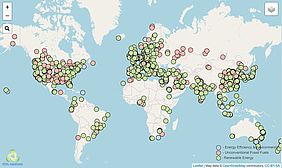QS Top Universities Rankings is an annual publication of university rankings by Quacquarelli Symonds (QS). It is composed in partnership with Elsevier and comprises the global overall and subject rankings together with five independent regional tables (Asia, Latin America, Emerging Europe and Central Asia, the Arab Region, and BRICS).QS Top Universities is the only international ranking to have received the approval of the International Ranking Expert Group (IREG).
The QS Top Universities Rankings by Subject rank the most popular universities worldwide in 51 individual subject areas. The methodology of the subject rankings is based on four parameters: Academic reputation, Employer reputation, Research citations per paper, H-index. The first two of these parameters comprise global surveys of academics and employers and are used to evaluate the international reputation of an institution in each subject. The second two indicators assess research impact, based on research citations per paper and H-index in the relevant subject. The H-index is a way of assessing both the productivity and impact of the published work of a scientist or scholar. It is based on the academic’s most cited papers and the number of citations that they have received in other publications. The citations were acquired from Elsevier’s comprehensive research citations database Scopus. For the complete engineering rankings, please visit the homepage of QS Top Universities.
In this year’s subject rankings, there are several interesting trends to be witnessed, the most impressive one being the remarkable gains made by Asian universities. Twenty six institutions from the continent participate in the global top 100, which is more than ever before. Chinese universities especially feature strongly among them. Japanese institutions, on the other hand, continue to decline in performance, partly due to underfunding for research and PhD students. Australian universities have also under-performed compared to last year. Elsewhere, the good academic performance of Russian universities should be mentioned, which have managed to increase their number of rated institutions.
In 2021, the engineering list is once again headed by the Massachusetts Institute of Technology (MIT), followed by Stanford University and the University of Cambridge. Founded in 1861, MIT has a polytechnic university model, emphasising laboratory instruction in applied science and engineering. The university plays an important role in the progress of many aspects of modern science, engineering and technology, and is widely known for its innovation and academic strength. MIT, for example, hosts the MIT Energy Initiative, which was founded in 2006 and has become MIT’s hub for energy research and education.There, research focuses, among other areas, on renewable energy technologies, such as solar thermal energy systems. In this field, scientists have developed for example a silica aerogel – an ultralight material which can be used in a solar thermal collector to generate temperatures suitable for water and space heating without using the expensive concentrators, special materials, and vacuum enclosures that are currently employed. Other research deals with CO2 capture, featuring, for example, battery-like systems that use a sorbent capturing CO2 in a plant in a specially-designed electrolyte which can separate the CO2 from the sorbent, increase the discharge of electricity from the battery and incorporate the CO2 into a solid that can serve as electrode material or be safely discarded. The University of Cambridge, meanwhile, is the world's fourth-oldest surviving university, and is affiliated with 121 Nobel laureates and 14 prime-ministers. One of its research institutions is the Energy Group, whose activity includes areas such as the modelling and control of combustion and its products, both in IC engines and gas turbines, with complementary activity in computational combustion.
Places four to ten are occupied by three European and three Asian universities, including: ETH Zurich and Nanyang Technological University, Singapore, in joint 4th position, the University of Oxford (6th place), the University of California, Berkeley (7th place), Imperial College London (8th place), National University of Singapore (9th place), Tsinghua University (10th place). Among the universities actively involved in the development of green technology systems are the National University of Singapore (NUS) and Tsinghua University. Tsinghua University, for example, hosts the Institute of Nuclear and New Energy Technologies, accommodating research divisions for direct methanol fuel cell development, biofuel production from sweet sorghum and cellulose or biogas production through solid-state fermentation.
Positions 11 to 20 are dominated by American (US – 5; CA – 1) and European universities (3). The only Asian institution to be found is KAIST – Korea Advanced Institute of Science & Technology, occupying 16th position. In total, the top 20 feature 9 American, 7 European and 4 Asian universities.
